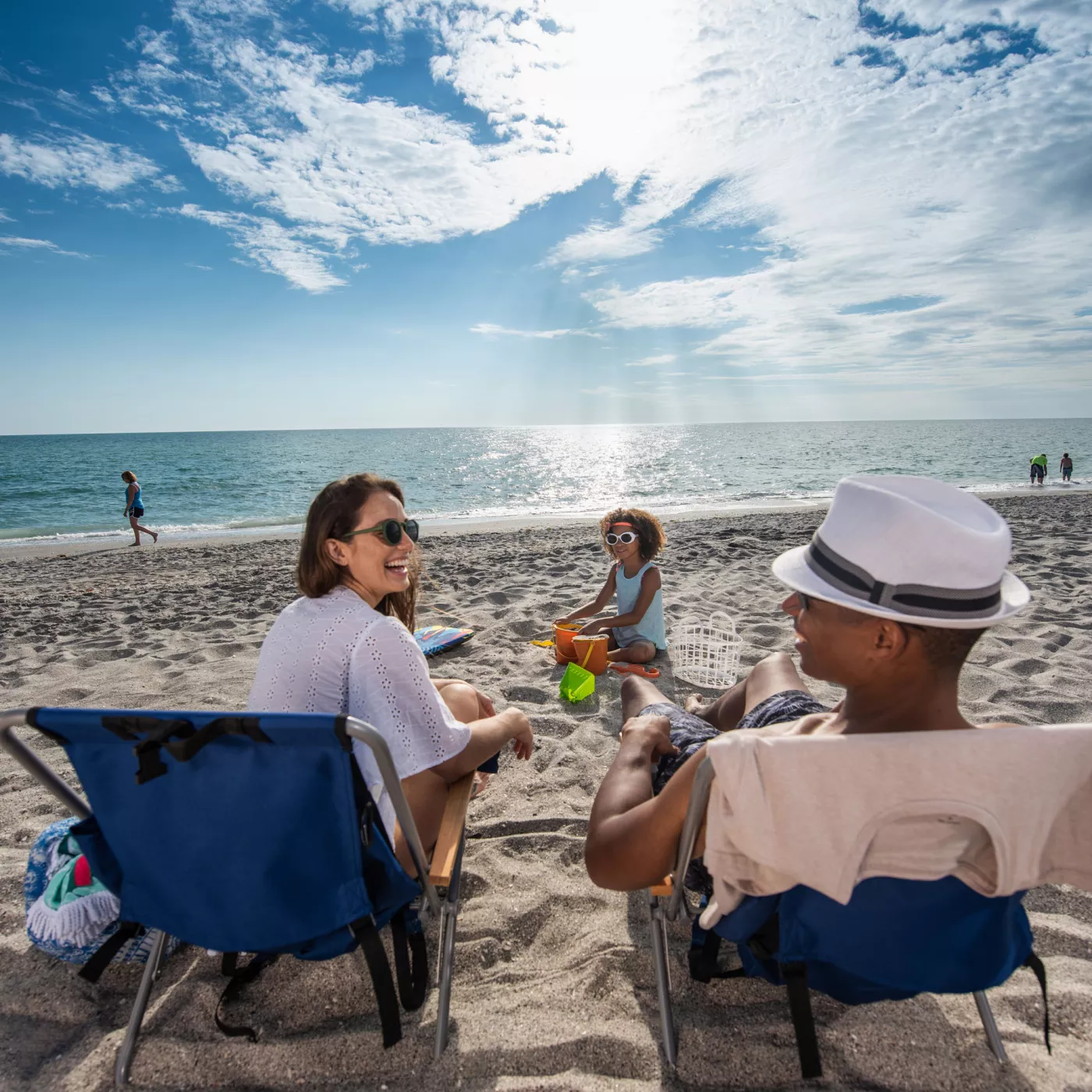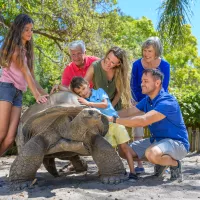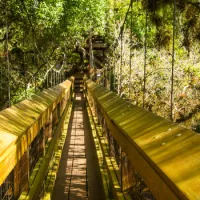Bertha Palmer: The Woman Who Tamed Wild Sarasota
Learn about Palmer's extraordinary agricultural innovations, her commitment to horticultural science and livestock-raising methods, and her savvy business acumen as foundational to the development of the Sarasota we know today
Learn about Palmer's extraordinary agricultural innovations, her commitment to horticultural science and livestock-raising methods, and her savvy business acumen as foundational to the development of the Sarasota we know today
When the millionaire matron of Chicago high society, Bertha Palmer, arrived in Sarasota in 1910, she encountered a mosquito-infested, boggy marshland that most assumed was uninhabitable. What the savvy businesswoman saw, however, was a tropical paradise with potential to become lucrative land for farming, ranching and leisure.
Palmer immediately purchased 140,000 acres of swampland comprising one-quarter of what would eventually become Sarasota County. The extent to which Palmer transformed that land in the years before her death in 1918, and her lasting influence on Sarasota's development and Florida agriculture, is remarkable.
Who Was Bertha Palmer?
At a glance, most wouldn't peg this sumptuously-attired high society woman as the person who would tame a rugged swampland and reform the livestock industry of an entire state.
Bertha Palmer the philanthropist helped host the Chicago World's Fair in 1893, and is often recognized for her connections to European royalty -- such as her personal friend and the son of Queen Victoria, Great Britain's King Edward VII. Her wealth was immense: Palmer decorated her Chicago mansion with artwork by Monet, Renoir and Picasso, which she scooped up on shopping sprees in Paris, and was known for wearing jewelry totaling tens of thousands of dollars in one sitting.

As unexpected as it may be, Palmer's late-in-life desire to master the best techniques for Florida agriculture was extraordinary. She consulted with top scientists from Florida land grant colleges, and she pored over papers produced by the USDA on topics such as cattle raising and experimental farming. She experimented with year-round growing techniques, such as planting vegetable crops between rows of slower-growing citrus trees.
Palmer's success using the the best agricultural science of her time is especially notable at Bee Ridge, where she developed a farming community; at Osprey, where she made her winter home at Historic Spanish Point, and on the land that now encompasses Myakka River State Park, where she introduced ranching techniques that would revolutionize Florida's cattle and hog industries.
Developing Profitable Farmland from Mucky Swampland
The agricultural subdivision Palmer created at Bee Ridge was one of the earliest of its kind in the United States. She transformed the 10,000 acre region by building a canal system to drain its marshes, and on the newly-drained land, she created ten and 20-acre farms which were honeycombed by smaller canals. Each farm was equipped with an artesian well and road access for a connected community.
Palmer advertised this new farmland to "gentleman farmers" from the north -- upper and middle class folk looking to escape big cities in exchange for a more pastoral existence during the "Back-to-the-land" movement that emerged in the early 20th century. To aid these city-slicker amateur farmers, Palmer offered space at her Bee Ridge Hotel, where the farmers could hold community meetings and network with more experienced agriculture professionals. She was also instrumental in the creation of the region's first farmer's market, which stimulated the local farm economy.
She transformed the 10,000 acre region by building a canal system to drain its marshes.
Bertha Palmer is also responsible for the development of approximately 5,000 acres of farmland at Osprey and the acquisition of the land today known as Palmer Farms, which her sons, Honoré and Potter II, would develop after her death.
Livestock Innovations
Among the greatest adversaries cattle ranchers faced in turn-of-the-century Florida was the Texas Tick, which drained the cows belonging to Florida's "cracker" ranchers of their health and resulted in poor market weights. Prior to Palmer's science-based intervention, the cracker ranching style permitted cattle to roam free, leaving them susceptible to parasites that thrive in the subtropical Florida wilderness.
"The form of cattle raising that took place when Bertha Palmer arrived in Florida dated back to the Spanish occupation, and most ranchers were not well educated. The Texas tick ran loose in the jungle and sapped the cows so they didn't have much meat on them. It was a curse throughout the American south," says historian, Frank A. Cassell, who authored the book, Suncoast Empire: Bertha Honoré Palmer, Her Family, and the Rise of Sarasota, 1910-1982.
Most notably, Palmer implemented livestock raising practices that adhered to USDA research, and she employed ranching techniques that were already being utilized with promising results in states that had robust cattle industries, such as Texas.
Palmer established 15,000 acres of citrus farms, hunting grounds, and ranch land (now Myakka State Park) which she called Meadowsweet Pastures. She brought in breeds of cattle that were best suited for their beef production.
Most notably, Palmer implemented livestock raising practices that adhered to USDA research, and she employed ranching techniques that were already being utilized with promising results in states that had robust cattle industries, such as Texas.

These practices include fencing pastures and a cattle dipping -- a relatively new technology of the time, in which livestock were dipped every two weeks in tar-like arsenic solutions to kill parasites. Fenced pastures prevented dipped cattle from re-entering the jungles where they were susceptible to ticks. Cattle dipping would become mandatory in the state of Florida in 1932, though it would be phased out in the 1960s.
Palmer also cut costs by sourcing a percentage of her livestock feed from local crop surplus. She experimented with storing this surplus feed in silos -- the footings of which can still be spotted near campgrounds at Myakka River State Park. Two of Palmer's antique cattle vats also exist in Myakka, where they stand as relics of the now-obsolete dipping practice.
Railroad Mogul
At the time of Palmer's arrival on Florida's Gulf Coast, the rail line ended at what was then the southernmost reaches of Manatee County, at a town called Fruitville. Most "roads" in the area were little more than sandy paths overgrown with scrub -- better suited for a mule team than a Ford Model T.
"When Bertha Palmer got off that train in 1910, it was literally the end of the line -- and at the end of that railroad line was the edge of a jungle," Cassell explains.
Palmer understood that modern means of transport would be crucial for the farms she created to be successful business ventures. Palmer leveraged her wealth, business acumen, and social influence to build railroads as far south as modern-day Venice.
"She understood that the agricultural world she was creating wouldn't work unless there were adequate railroad connections to carry crops north and west."
—Frank Cassell, author and local historian
"One of the first things she does by 1911 is cut a deal with Seaboard Air Line Railroad to extend the tracks from Sarasota to Fruitville and then south to Venice. She understood that the agricultural world she was creating wouldn't work unless there were adequate railroad connections to carry crops north and west, up as far as Canada. The railroad was absolutely critical to Sarasota's success," says Cassell.
Palmer also advocated the development of local roadways that provided early automotive access throughout the region -- and would ultimately define county lines between Manatee and up-and-coming Sarasota.
Remarkable Accomplishments for Age, Gender and Time
What makes Palmer's contributions to the development of Sarasota County particularly extraordinary is the age at which she first set to work on them -- during the sixth and final decade of her life -- and in an era when women's rights were limited.
Sarasota County celebrates its centennial one year after the 100th anniversary of the Nineteenth Constitutional Amendment that granted women the right to vote -- an amendment that passed two years after Palmer's death in 1918, at the age of 69. The life she led -- both as a bejeweled social influencer, and later, when she fished and hunted quail for sport in the Florida swamplands during her twilight years -- was as nuanced as it was illustrious.
What makes Palmer's contributions particularly extraordinary is the age at which she first set to work on them—during the sixth and final decade of her life—and in an era when women's rights were limited.
"Late in life, when she had money galore, there was really no need for her to do anything, and yet: this was a woman who was very bright and who excelled at everything she turned her hand to, but who is not nearly as predictable as you'd think she might be -- especially when you look at pictures and see this rich lady with big hats and jewelry piled around her," says Cassell.
"She played golf, she fished, and she loved to motor at a time when motoring was a sport. She went to Europe before World War I, and she drove all over the place. She had speed boats. She was extraordinarily social. She threw great parties at Spanish Point for her neighbors and local young people," he adds.
Locating This Legacy in Modern Sarasota
To this day, Bertha Palmer's influence occupies physical spaces throughout Sarasota County.
When you bike the Legacy Trail, try to imagine the untamed wilderness the Chicago socialite encountered upon her arrival by locomotive in 1910. This multi-use trail across 12.5 miles stretches from Palmer Ranch to the Venice Train Depot, crossing through Nokomis and Osprey with trailheads at Oscar Scherer State Park, and along the former Seaboard Air Line railroad route -- which Palmer was responsible for extending to modern day downtown Venice.
Visit Palmer's estate at Selby Gardens Historic Spanish Point Campus in Osprey, where a number of the original gardens designed and touched by her own hands remain today. Find her memory, also, at Myakka State Park, on the land where Palmer modernized Florida cattle ranching, and where she brought her grandchildren camping, and encouraged them to learn how to hunt and fish.
Still looking to learn more about Bertha Palmer's life in Florida and the influence the Palmer family had throughout Sarasota County in the decades following her death? Find Frank A. Cassell's book, Suncoast Empire: Bertha Honoré Palmer, Her Family, and the Rise of Sarasota, 1910-1982, in Sarasota County libraries and for purchase online.

![Boat parking at The Crow’s Nest in Venice [Photo: Lauren Jackson]](/sites/default/files/styles/popular_stories_teaser/public/2023-import/The-Crow%2527s-Nest-cropped__OPT.jpg.webp?itok=ycs37M-O)


